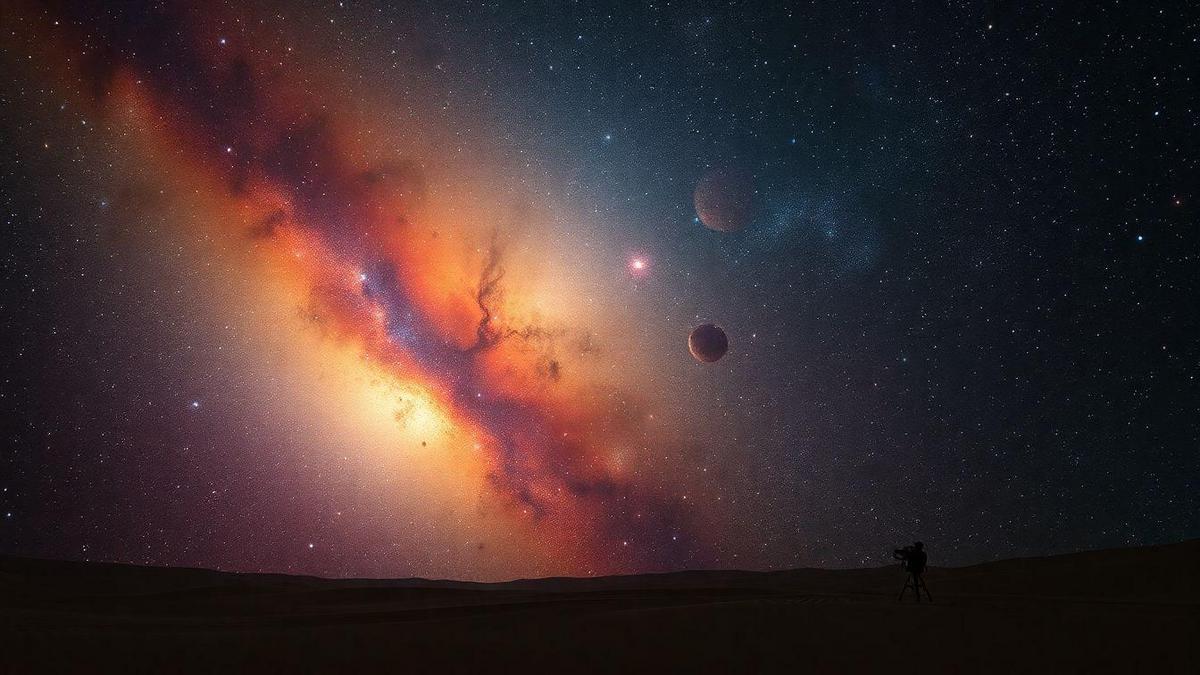
The first stars in the universe, known as Population III stars, played a fundamental role in cosmic formation and evolution. These stars emerged during a period known as the “Era of Recombination,” around 400 million years after the Big Bang, when the universe was still in its infancy. Composed almost exclusively of hydrogen and helium, these stars lacked the heavy elements we know today—such as carbon and oxygen—produced through nuclear fusion in more evolved stars. Studying Population III is essential to understanding how the universe has transformed over billions of years.
Understanding Population III stars is not only a matter of scientific curiosity but also a key to unlocking many mysteries of modern cosmology. These stars influenced galaxy formation, the creation of new elements, and the development of large-scale cosmic structures. Learning how these stars functioned and their consequences for the early universe provides valuable insights into the nature of matter and energy that make up the cosmos. Therefore, exploring Population III is essential for any effort to comprehend the universe’s history.
How Did the First Population III Stars Work?
Population III stars are considered the first generation of stars formed in the universe. They emerged from primordial gas clouds composed mainly of hydrogen and helium, collapsing under the influence of gravity. This collapse created extreme temperatures and pressures in their cores, allowing nuclear fusion to begin. The fusion of hydrogen into helium powered these stars, enabling them to shine for their relatively short lifetimes. Unlike stars we observe today, Population III stars were significantly more massive and energetic.
One of the most intriguing features of Population III stars is their lack of heavy elements, such as carbon and oxygen. This meant their nuclear fusion processes were different, resulting in highly efficient energy production but very short lifespans. These stars rapidly consumed their fuel and often ended their lives in powerful supernova explosions, releasing enormous amounts of energy and newly formed elements into intergalactic space.
Following these explosions, Population III stars contributed to the formation of the next generation of stars, known as Population II. The heavy elements created in their supernovae enriched the surrounding gas clouds, giving rise to chemically richer stars. This recycling process is fundamental to stellar evolution and the eventual formation of planets, including our own.
Moreover, Population III stars also influenced galaxy formation. The intense radiation emitted by these primordial stars ionized the surrounding gas, creating ionized regions that became the birthplaces of new stars and galaxies. This interaction between stars and the interstellar medium is key to understanding the structure of the universe and its long-term evolution.

Benefits of Understanding Population III Star Formation
Understanding the formation of Population III stars offers several advantages for astrophysics and cosmology. First, studying these stars allows us to better grasp the conditions of the early universe. By investigating when and how the first stars formed, scientists can reconstruct the history of the cosmos from the Big Bang to the present day, revealing critical information about cosmic evolution.
Additionally, Population III stars are essential for understanding stellar nucleosynthesis—the process by which chemical elements are formed inside stars. Research into how these stars produced heavy elements gives insights into the origin of the matter that makes up not only stars, but also planets and life itself. Understanding nucleosynthesis is also key to cosmic chemistry and the formation of complex molecules that may lead to life.
Another important aspect is the connection between Population III and galaxy formation. These primordial stars played a crucial role in the creation of the first galaxies. Understanding their formation and evolution helps us uncover the mysteries of modern galaxies, including their structure, the formation of supermassive black holes, and the dynamics of galactic interactions.
Finally, studying Population III has major implications for modern cosmology. The radiation and elements generated by these stars influenced the universe on large scales, affecting the distribution of matter and energy. Understanding these processes is essential for building accurate cosmological models that explain the large-scale structure of the universe and its expansion.
How Population III Stars Influenced the Early Universe
-
Radiation from the First Stars and Its Importance: Population III stars emitted intense radiation that ionized the surrounding gas, creating ionized regions where new stars and galaxies could form. This radiation played a key role in shaping the interstellar medium and enabling further cosmic evolution.
-
Chemical Elements Produced by Population III: During their lifetimes and explosive deaths, Population III stars generated heavy elements like carbon, oxygen, and iron. These elements were spread into space through supernovae, enriching the interstellar medium and allowing for the formation of later stars and planetary systems—crucial for life’s chemistry.
-
The Relationship Between Ancient Galaxies and Population III: Population III stars were instrumental in forming the earliest galaxies. Their radiation and element production influenced the formation and development of galaxies, helping shape the universe’s current structure.
-
The Role of Astrophysics in Understanding Population III: Astrophysics is essential in the study of Population III stars. Through computational simulations and advanced telescope observations, scientists can investigate the conditions that led to the formation of these stars and how they impacted the early universe.
-
How Cosmology Benefits from Studying Population III: Studying Population III provides valuable information about the universe’s evolution and large-scale structure. Understanding these stars helps cosmologists build more accurate models explaining cosmic expansion and matter distribution.
-
Stellar Evolution and Its Impact on the Universe: The life cycles of Population III stars profoundly shaped the universe, from the creation of heavy elements to the formation of galaxies. Understanding stellar evolution is fundamental for tracing the cosmic history and the origin of all matter around us.
The study of Population III stars is thus a fascinating and vital area of research in astrophysics and cosmology. These stars not only shaped the early universe but also provided the elements and conditions necessary for new stars, planets, and potentially life itself. Ongoing exploration of this topic promises to reveal even more secrets about our origins and the cosmos.

Did You Enjoy Learning About the First Stars: Focus on Population III?
Learning about the first stars—Population III—is a fascinating journey through the universe’s earliest history. These stars not only illuminated the primordial cosmos but also played a critical role in forming everything we know today. The quest to understand these ancient stars is a key to unlocking the mysteries of the universe.
Research on Population III continues to evolve, with new discoveries emerging constantly. Their impact on galaxy formation and cosmic chemistry offers a rich field of exploration. We hope this article sparked your curiosity and encourages you to continue exploring the secrets of the cosmos.
Frequently Asked Questions
What are the first stars: Focus on Population III?
The first stars, known as Population III, are the oldest stars in the universe. They formed shortly after the Big Bang and were made almost entirely of hydrogen and helium.
Why is Population III important?
Population III is important because it helped shape the universe as we know it. These stars produced the first heavy elements, which are essential for life.
How do we know these stars existed?
Scientists study light from distant galaxies. That light can contain clues about the first stars. Powerful telescopes help in this search.
Can we see the first stars today?
No, the first stars cannot be seen directly. But astronomers look for galaxies that carry signs of their existence, giving us indirect evidence.
What happened to Population III?
It’s believed that the first stars exploded as supernovae. These explosions released new elements into space, forming the next generation of stars and planets.
Could studying Population III stars help us understand the origin of life?
Yes. Since Population III stars produced the first heavy elements like carbon, oxygen, and iron—essential for planets and life—their study helps scientists trace the cosmic origins of the building blocks necessary for biology. Understanding how and when these elements first appeared sheds light on the conditions that made life possible in the universe.

